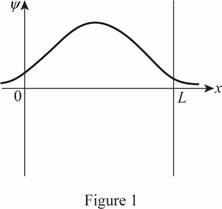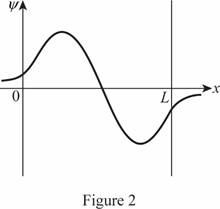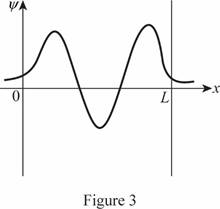
Concept explainers
(a)
The sketches of the wave function of a particle confined in a finite box.
(a)
Answer to Problem 71P
The wave function is given below.
Explanation of Solution
For a particle in a box, the wave function in the
For

Since the wave function is a sinusoidal curve decaying outside the box, the box contains less than half the wavelength. Thus,
i.e.
Here,
For

Since the wave function is a sinusoidal curve decaying outside the box, the box contains less than one wavelength and more than half the wavelength.
i.e.
For

Since the wave function is a sinusoidal curve decaying outside the box, the box contains less than
i.e.
From all the above given wave functions, it can be generalised that
Here,
(b)
Check whether the condition
(b)
Answer to Problem 71P
Yes. The given condition is valid for a particle confined in a finite box.
Explanation of Solution
The energy of
Write the expression for energy of a particle in a infinite box in terms of wavelength
Here,
Rearranging (II) for
Write the expression for ground state energy
Write expression (I)
Taking reciprocal and squaring (I)
While taking reciprocal, the direction of inequality changes.
Multiplying (III) by
Substituting (III) in (VI)
Substituting for
Cancelling out the common terms in numerator and denominator
Thus, the given condition is valid.
Want to see more full solutions like this?
Chapter 28 Solutions
Physics
- A man holds a double-sided spherical mirror so that he is looking directly into its convex surface, 33 cm from his face. The magnification of the image of his face is +0.17. What will be the image distance when he reverses the mirror (looking into its concave surface), maintaining the same distance between the mirror and his face? Be sure to include the algebraic sign (+ or -) with your answer.arrow_forwardHow do you draw a diagram of the ruler and mass system in equilibrium identifying the anti-clockwise torque and clockwise torque? How do I calculate the anti-clockwise torque and the clockwise torque of the system with the ruler and the washers, does it come from the data in table 4? Please help, thank you!arrow_forwardExample Double pane windows have two panes of glass (n = 1.5), with a layer of air sandwiched between them. If light from outside enters the first pane at an angle of 25° from the surface normal, what angle does it enter the house at? ☑ 3 5arrow_forward
- Did your experiment results in Data Table 3 verify, to within a reasonable experimental error, the condition of equilibrium of Equation 6: Στanti-clockwise = Στclockwise? Support your response with experimental data. What does this Σ mean? My results do not show they are equal to each other, what does this mean then, and what does the data show? Thanks!arrow_forwardmicro wave.arrow_forwardmicro wave.arrow_forward
- kerjakanarrow_forwardAn object is placed 37.4cm in front of a diverging lens with a focal length of 18.1 cm. Please provide your answers in units of cm if necessary. bookmark_border1.0p3a Find the image distance. Answer Updated 6 days ago Show feedback bookmark_border1.0p3b Is the image real or virtual? Real Virtual Updated 6 days ago Show feedback bookmark_border1.0p3c Suppose the object is brought to a distance of 10.3 cm in front of the lens. Where is the image now with respect to its previous location? (Note: Ensure the sign convention you use is consistent by treating all image distances on the object side of the lens as negative.) Answer Updated 7 minutes ago Show feedback bookmark_border1.0p3d How has the height of the image changed if the object is 84.2 cm tall? Answerarrow_forwardn object is placed 37.4cm in front of a diverging lens with a focal length of 18.1 cm. Please provide your answers in units of cm if necessary. bookmark_border1.0p3a Find the image distance. Answer Updated 6 days ago Show feedback bookmark_border1.0p3b Is the image real or virtual? Real Virtual Updated 6 days ago Show feedback bookmark_border1.0p3c Suppose the object is brought to a distance of 10.3 cm in front of the lens. Where is the image now with respect to its previous location? (Note: Ensure the sign convention you use is consistent by treating all image distances on the object side of the lens as negative.) Answer Updated just now Show feedback bookmark_border1.0p3d How has the height of the image changed if the object is 84.2 cm tall? Answerarrow_forward
 College PhysicsPhysicsISBN:9781305952300Author:Raymond A. Serway, Chris VuillePublisher:Cengage Learning
College PhysicsPhysicsISBN:9781305952300Author:Raymond A. Serway, Chris VuillePublisher:Cengage Learning University Physics (14th Edition)PhysicsISBN:9780133969290Author:Hugh D. Young, Roger A. FreedmanPublisher:PEARSON
University Physics (14th Edition)PhysicsISBN:9780133969290Author:Hugh D. Young, Roger A. FreedmanPublisher:PEARSON Introduction To Quantum MechanicsPhysicsISBN:9781107189638Author:Griffiths, David J., Schroeter, Darrell F.Publisher:Cambridge University Press
Introduction To Quantum MechanicsPhysicsISBN:9781107189638Author:Griffiths, David J., Schroeter, Darrell F.Publisher:Cambridge University Press Physics for Scientists and EngineersPhysicsISBN:9781337553278Author:Raymond A. Serway, John W. JewettPublisher:Cengage Learning
Physics for Scientists and EngineersPhysicsISBN:9781337553278Author:Raymond A. Serway, John W. JewettPublisher:Cengage Learning Lecture- Tutorials for Introductory AstronomyPhysicsISBN:9780321820464Author:Edward E. Prather, Tim P. Slater, Jeff P. Adams, Gina BrissendenPublisher:Addison-Wesley
Lecture- Tutorials for Introductory AstronomyPhysicsISBN:9780321820464Author:Edward E. Prather, Tim P. Slater, Jeff P. Adams, Gina BrissendenPublisher:Addison-Wesley College Physics: A Strategic Approach (4th Editio...PhysicsISBN:9780134609034Author:Randall D. Knight (Professor Emeritus), Brian Jones, Stuart FieldPublisher:PEARSON
College Physics: A Strategic Approach (4th Editio...PhysicsISBN:9780134609034Author:Randall D. Knight (Professor Emeritus), Brian Jones, Stuart FieldPublisher:PEARSON





